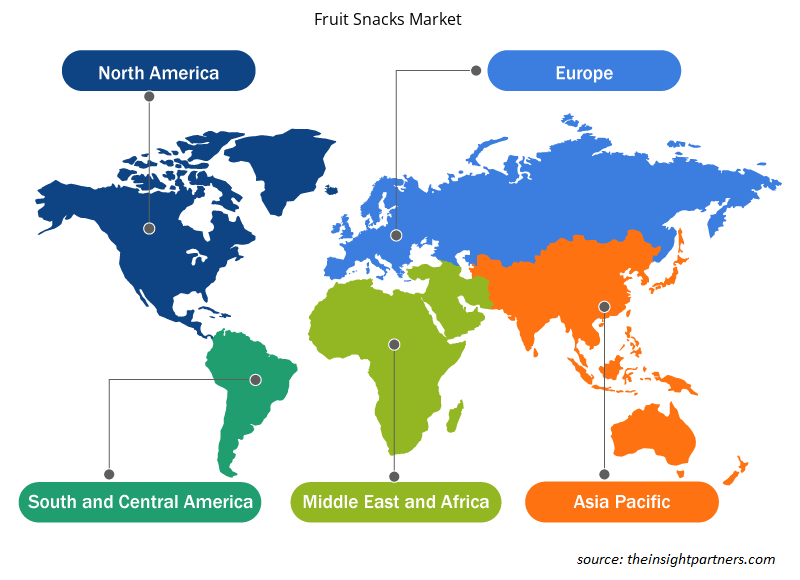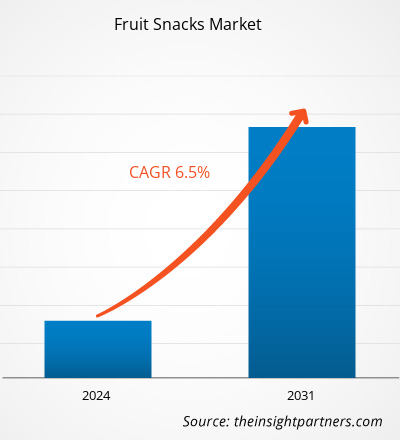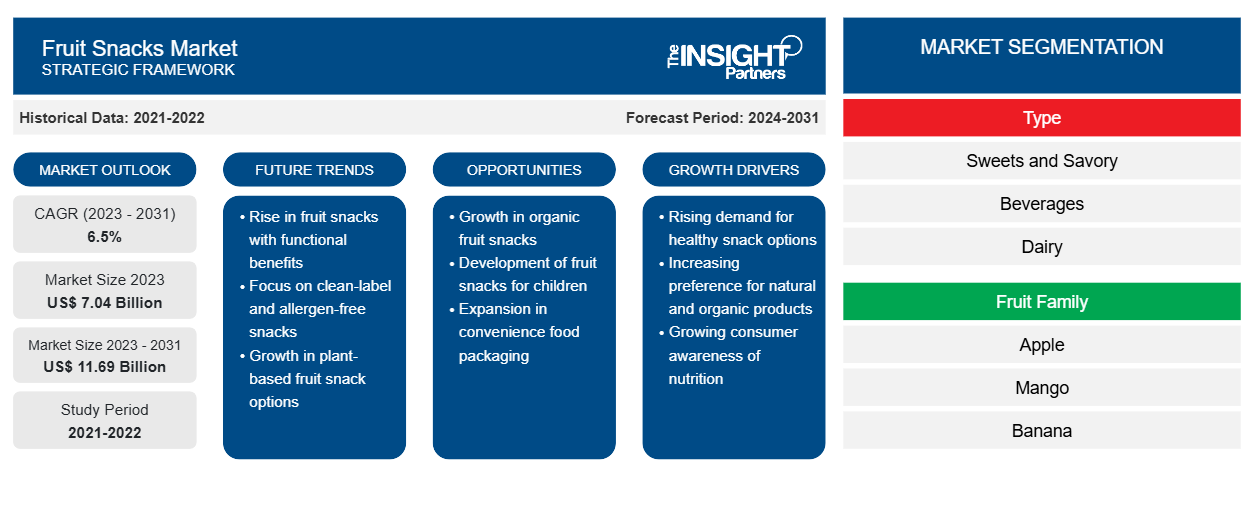Se proyecta que el tamaño del mercado de snacks de frutas alcance los 11.690 millones de dólares estadounidenses en 2031, frente a los 7.040 millones de dólares estadounidenses en 2023. Se espera que el mercado registre una CAGR del 6,5 % en 2023-2031. El mercado de snacks de frutas está experimentando un crecimiento sustancial impulsado por la creciente demanda de alimentos y snacks saludables. Los avances en el mercado de snacks de frutas se atribuyen al auge de la tendencia de la salud y el bienestar, que lleva a una preferencia por snacks bajos en calorías y ricos en nutrientes. El mercado está siendo testigo de un aumento en la demanda de snacks de frutas naturales y de etiqueta limpia y ofertas de sabores innovadores. La comodidad de los snacks de frutas y su disponibilidad en varios canales minoristas contribuyen aún más a la expansión del mercado, lo que lo convierte en un área clave de interés tanto para los consumidores como para los fabricantes.
Análisis del mercado de snacks de frutas
Los snacks de frutas tienen un alto contenido nutricional y ofrecen varios beneficios para la salud. La creciente demanda de alimentos libres de culpa y la concienciación sobre los hábitos alimentarios saludables. La evolución de las tendencias de alimentación saludable y el lanzamiento de snacks de frutas como ingrediente están impulsando la demanda de snacks de frutas. Según el mayorista británico Epicurium, las ventas de snacks saludables crecieron un 39% en 2023, en comparación con 2022. La transición hacia una alimentación saludable ha animado a los fabricantes a presentar snacks de frutas finos y de alta calidad en el mercado. Por ejemplo, Nutty Goodness, LLC ofrece chips de manzana saludables elaborados con frutas y frutos secos orgánicos, sin conservantes, trigo, soja o lácteos, gluten o cualquier azúcar añadido.
Descripción general del mercado de snacks de frutas
Los snacks de frutas se producen a partir de frutas reales y se procesan en varias formas, como barras, gomitas, rollos, peladores, frutas recubiertas y bebidas, específicamente para atraer a la base de clientes objetivo. Los snacks se fabrican utilizando varias frutas, como fresa, frambuesa, naranja, piña, mango y mezclas. Además, los snacks a base de frutas también se producen agregando frutas en bebidas o productos lácteos como yogur y batidos. La adición de frutas ayuda a aumentar el contenido nutricional del producto, al mismo tiempo que mejora su perfil sensorial. Los snacks de frutas mínimamente procesados con alto contenido de frutas tienen nutrientes esenciales como potasio, vitaminas, magnesio y fibra. Se espera que la creciente demanda de snacks para llevar y la transición global hacia una alimentación saludable impulsen el crecimiento del mercado.
Personalice este informe según sus necesidades
Obtendrá personalización en cualquier informe, sin cargo, incluidas partes de este informe o análisis a nivel de país, paquete de datos de Excel, así como también grandes ofertas y descuentos para empresas emergentes y universidades.
- Obtenga las principales tendencias clave del mercado de este informe.Esta muestra GRATUITA incluirá análisis de datos, desde tendencias del mercado hasta estimaciones y pronósticos.
Impulsores y oportunidades del mercado de snacks de frutas
Conveniencia de Snacks de Frutas para Favorecer el Mercado
La comodidad de los snacks de frutas actúa como un factor importante en el mercado debido a su envase portátil, que se adapta a estilos de vida ajetreados y al consumo en movimiento. Además, la disponibilidad inmediata de una variedad de productos alimenticios procesados, incluidos los snacks de frutas, proporciona opciones rápidas y fácilmente transportables, lo que satisface la creciente demanda de snacks listos para comer y productos alimenticios de conveniencia. En general, la comodidad de los snacks de frutas preenvasados se alinea con la necesidad del consumidor moderno de opciones de snacks rápidos, portátiles y nutritivos, lo que impulsa la demanda de snacks de frutas en el mercado.
La creciente demanda de productos naturales y de etiqueta limpia: una oportunidad
Una oportunidad en el mercado de snacks de frutas reside en la creciente demanda de productos naturales y de etiqueta limpia. Los consumidores perciben los productos naturales como saludables. Según un informe de Glanbia Nutritionals, el 40% de los consumidores perciben los snacks que no contienen aditivos ni conservantes como snacks saludables, mientras que el 33% de los consumidores percibe los ingredientes naturales y la etiqueta limpia como los principales atributos que hacen que los alimentos sean productos saludables. Además, la expansión del mercado de barritas de frutas en los países en desarrollo, impulsada por las preferencias cambiantes de los consumidores, significa un mayor potencial de crecimiento del mercado.
Análisis de segmentación del informe de mercado de snacks de frutas
Los segmentos clave que contribuyeron a la derivación del análisis del mercado de snacks de frutas son el tipo, la familia de frutas y el canal de distribución.
- Según el tipo, el mercado de snacks de frutas se divide en gomitas y hojuelas, barras y rollitos, bebidas y otros. El segmento de gomitas y hojuelas tuvo una participación de mercado significativa en 2023.
- En cuanto a las frutas, el mercado está segmentado en manzana, mango, plátano, piña, frutos rojos y otros. El segmento de frutos rojos tuvo una participación significativa en 2023.
- Según el canal de distribución, el mercado se segmenta en supermercados e hipermercados, tiendas de conveniencia, venta minorista en línea y otros. El segmento de supermercados e hipermercados tuvo una participación significativa en 2023.
Análisis de la cuota de mercado de snacks de frutas por geografía
El alcance geográfico del informe del mercado de snacks de frutas se divide principalmente en cinco regiones: América del Norte, Asia Pacífico, Europa, Medio Oriente y África, y América del Sur/América del Sur y Central.
La región de Asia Pacífico tiene una importante participación en el mercado de snacks de frutas. La creciente demanda de opciones de alimentos novedosos y convenientes y las preferencias cambiantes de los consumidores han llevado a la expansión del mercado de snacks de frutas en la región de Asia Pacífico. Uno de los factores clave que impulsa el crecimiento del mercado de snacks de frutas en la región de Asia Pacífico es la creciente influencia de las tendencias alimentarias saludables y sin culpa. La creciente penetración del comercio electrónico en los países asiáticos ha animado a los principales actores del mercado a mejorar su presencia en línea mediante la venta de snacks de frutas a través de Amazon, Walmart y sitios web de marcas individuales. Por lo tanto, se espera que el aumento de la concienciación sobre la salud impulse aún más la expansión del mercado mundial de snacks de frutas en los próximos años.
Perspectivas regionales del mercado de snacks de frutas
Los analistas de Insight Partners explicaron en detalle las tendencias y los factores regionales que influyen en el mercado de snacks de frutas durante el período de pronóstico. Esta sección también analiza los segmentos y la geografía del mercado de snacks de frutas en América del Norte, Europa, Asia Pacífico, Oriente Medio y África, y América del Sur y Central.

- Obtenga datos regionales específicos para el mercado de snacks de frutas
Alcance del informe de mercado de snacks de frutas
| Atributo del informe | Detalles |
|---|---|
| Tamaño del mercado en 2023 | US$ 7.04 mil millones |
| Tamaño del mercado en 2031 | US$ 11,69 mil millones |
| CAGR global (2023 - 2031) | 6,5% |
| Datos históricos | 2021-2022 |
| Período de pronóstico | 2024-2031 |
| Segmentos cubiertos | Por tipo
|
| Regiones y países cubiertos | América del norte
|
| Líderes del mercado y perfiles de empresas clave |
|
Densidad de actores del mercado: comprensión de su impacto en la dinámica empresarial
El mercado de snacks de frutas está creciendo rápidamente, impulsado por la creciente demanda de los usuarios finales debido a factores como la evolución de las preferencias de los consumidores, los avances tecnológicos y una mayor conciencia de los beneficios del producto. A medida que aumenta la demanda, las empresas amplían sus ofertas, innovan para satisfacer las necesidades de los consumidores y aprovechan las tendencias emergentes, lo que impulsa aún más el crecimiento del mercado.
La densidad de actores del mercado se refiere a la distribución de las empresas o firmas que operan dentro de un mercado o industria en particular. Indica cuántos competidores (actores del mercado) están presentes en un espacio de mercado determinado en relación con su tamaño o valor total de mercado.
Las principales empresas que operan en el mercado de snacks de frutas son:
- Snacks desnudos
- Verde crujiente inc.
- Compañía: General Mills Inc.
- Ferrero
- Alimentos de Mount Franklin, LLC
Descargo de responsabilidad : Las empresas enumeradas anteriormente no están clasificadas en ningún orden particular.

- Obtenga una descripción general de los principales actores clave del mercado de snacks de frutas
Noticias y desarrollos recientes del mercado de snacks de frutas
El mercado de snacks de frutas se evalúa mediante la recopilación de datos cualitativos y cuantitativos posteriores a la investigación primaria y secundaria, que incluye publicaciones corporativas importantes, datos de asociaciones y bases de datos. A continuación, se incluye una lista de los avances en el mercado de trastornos del habla y el lenguaje y las estrategias:
- La marca de snacks de frutos secos Rind Snacks lanzó la edición limitada de Peach Chips. Los Peach Chips están elaborados con duraznos de California y fuentes añadidas de vitaminas A y C. El producto no incluye conservantes ni azúcares añadidos y es naturalmente vegano, sin gluten, con certificación Koshar y verificado como no transgénico. (Fuente: Rind Snacks/Sitio web de la empresa/2022)
- LesserEvil, la marca de snacks saludables, colaboró con Rind Snacks y lanzó una edición limitada de palomitas de maíz sabor cereza y lima. Las palomitas se prepararon con aceite de coco y se espolvorearon con polvos de frutas de cereza y lima. (Fuente: LesserEvil/Sitio web de la empresa/2022)
Informe de mercado de snacks de frutas: cobertura y resultados
El informe “Tamaño y pronóstico del mercado de snacks de frutas (2021-2031)” proporciona un análisis detallado del mercado que cubre las siguientes áreas:
- Tamaño del mercado y pronóstico a nivel global, regional y nacional para todos los segmentos clave del mercado cubiertos bajo el alcance
- Dinámica del mercado, como impulsores, restricciones y oportunidades clave
- Principales tendencias futuras
- Análisis detallado de las cinco fuerzas de Porter y PEST y FODA
- Análisis del mercado global y regional que cubre las tendencias clave del mercado, los principales actores, las regulaciones y los desarrollos recientes del mercado.
- Análisis del panorama de la industria y de la competencia que abarca la concentración del mercado, el análisis de mapas de calor, los actores destacados y los desarrollos recientes
- Perfiles detallados de empresas
- Análisis histórico (2 años), año base, pronóstico (7 años) con CAGR
- Análisis PEST y FODA
- Tamaño del mercado, valor/volumen: global, regional y nacional
- Industria y panorama competitivo
- Conjunto de datos de Excel
Informes recientes
Informes relacionados
Testimonios
Razón para comprar
- Toma de decisiones informada
- Comprensión de la dinámica del mercado
- Análisis competitivo
- Información sobre clientes
- Pronósticos del mercado
- Mitigación de riesgos
- Planificación estratégica
- Justificación de la inversión
- Identificación de mercados emergentes
- Mejora de las estrategias de marketing
- Impulso de la eficiencia operativa
- Alineación con las tendencias regulatorias





















 Obtenga una muestra gratuita para - Mercado de snacks de frutas
Obtenga una muestra gratuita para - Mercado de snacks de frutas